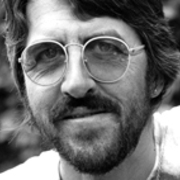
Peter Janes
The CV for cameraman Peter Janes runs for many pages, but perhaps the most interesting section is at the end, which compiles eclectic highlights from his 40 year career. The music-mad Janes makes sure to include work with dozens of bands from The Fourmyula to trailblazers from the Flying Nun stable; he also mentions encounters with snakes, sharks, an active volcano, and locations across the globe.
At age seven, Sussex-born Janes decamped from England to Hastings, New Zealand. Consumed by music and fortunate enough to be of teen-age as the Beatles were conquering the world’s music charts, he soon decided that radio was the best place to be.
At the start of 1967 Janes joined the NZ Broadcasting Corporation, with visions of spinning platters for hipster DJs Peter Sinclair or Keith Richardson. It was not to be. Instead Janes was sent to the NZBC’s television arm; although at least he was in the sound department. Each week he set out with a cameraman to record items for varied shows from news to Country Calendar. One time he filmed The Who at Wellington Airport, as Pete Townsend spoke of wanting to punch a local music critic.
Janes soaked up information in the highly convivial cameraroom, from comparatively old hands Waynne Williams and Alun Bollinger (the latter soon to become a flatmate). Self-described as a “fairly average soundman”, Janes only lasted 18 months in the job before transferring to the camera department. He was promptly given a light meter and sent out to film a story, which aired that night on the primetime news.
Later Janes helped out Williams on historical drama The Killing of Kane, the first local TV production shot in colour. In 1973 he captured images of local Hells Angels members for notorious bikie doco If You’re in it, You’re in it to the Limit, which was promptly banned by the NZBC. In this period Janes left the state broadcaster (returning in 1975) to spend time as a freelancer, and overseas. The local projects included a Country Calendar special introducing us to life on Fred Dagg’s farm, and time in the Wairarapa, shooting a dramatised documentary in which Bruno Lawrence played mercenary Gustavus von Tempsky.
Music forms a major thread in Janes' career. He has shot images of Kiwi acts of all hues, alongside many visiting bands from overseas. The experiments in sound and vision began early. Janes began playing around with music clips while filming for Town and Around in the late 60s; in 1968 he created a clip to accompany Beatles epic A Day in the Life with editor Chris Mangin (alongside Alun Bollinger, the pair also borrowed gear to shoot a short western on weekends).
A decade later, when Janes transferred to TVNZ’s Dunedin operation from Wellington, he found himself on hand to capture images of emerging players in the punk and post-punk music scene. Janes directed documentary items for late night music show Radio with Pictures on punk music (Have You Checked the Children Lately?), band Tall Dwarfs (A Pointless Exercise) and the music scene across the four main centres.
Production of local music videos was jumping exponentially, to match the rise in local music; Peter Blake, head of TVNZ’s so-called ‘Rock Unit’, began slipping film stock to Janes, allowing him to make music videos for a plethora of Flying Nun bands with 'the' in their title, including The Chills, The Bats, The Clean, and Clean offshoot The Great Unwashed (for whom he directed one of his favourite videos of all: Obscurity Blues). He also has fond memories of shooting classic Verlaines clip Death and the Maiden, largely in a beloved student flat in Dunedin, alongside various Flying Nun folk.
In 1984 Janes moved to Sydney, where he lucked out with a globetrotting job on hit children’s show Simon Townsend’s Wonder World. After working on a range of freelance gigs in Australia (including travels across the Pacific for 1993 series Tagata Tangata) he ended up driving a cab.
When Janes returned to New Zealand that year, he reinvented himself as a cameraman on drama and comedy projects, but still kept his hand in with the odd documentary. After operating camera on Marlin Bay and City Life, he was promoted to director of photography on Jackson’s Wharf and a run of TV shows starring Pio Terei and the Topp Twins. Janes also will not quickly forget spending four months filming at Rimutaka Prison for Locked Down; he was sad to see the series "buried" at 10.30pm on a Tuesday night.
In 2009 Janes was director of photography on The Table Plays, an anthology of one-off dramas made for Māori Television. Earlier he had made a rare venture into feature films, as camera operator on Don Selwyn’s “beautiful” teo reo take on Shakespeare, The Māori Merchant of Venice.
Since 2008 Janes has been alternating screenwork with time in the Hawkes Bay, teaching filmmaking at Napier’s Eastern Institute of Technology.
Profile written by Ian Pryor
Originally published on 8 July 2013; updated on 29 September 2021
Sources include
Peter Janes
Peter Janes, ‘If my memory serves me well: Recollections of a cameraman’ - NZTecho, Winter 2010 Issue 53, page 6
'Peter Blake: On making music and getting Ready to Roll' (Video Interview) NZ On Screen website. Director Ian Pryor (Uploaded 3 April 2013) Accessed 25 January 2019